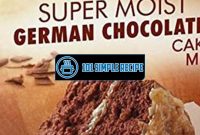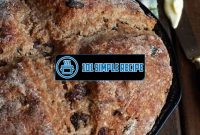If you’re looking for a delectable and nutritious bread recipe to satisfy your cravings and support your healthy lifestyle, look no further than this delicious and healthy whole wheat bread recipe. ✨ This recipe not only provides a mouthwatering taste but also incorporates the many health benefits of whole wheat. The inclusion of whole wheat flour in this recipe ensures a higher content of fiber, vitamins, and minerals, boosting the nutritional value of your daily bread. Moreover, this homemade bread lets you avoid the preservatives and artificial additives found in store-bought bread, allowing you to fully enjoy the natural goodness of freshly baked bread. Get ready to embrace the exquisite flavor and incredible health benefits of this wholesome treat.

Understanding the Basics of Whole Wheat Bread
When it comes to bread, whole wheat bread stands out as a nutritious and wholesome option that offers a wide range of health benefits. In comparison to white bread, which is made from refined grains, whole wheat bread is made from whole wheat kernels that contain all three parts of the grain – the bran, germ, and endosperm. This means that whole wheat bread retains a higher nutritional value and offers numerous advantages for your overall well-being.
What is Whole Wheat Bread
Whole wheat bread is a type of bread that is made from whole wheat flour, which is derived from grinding whole wheat kernels. The whole wheat kernels consist of three main components:
- Bran: The outer layer of the grain that is rich in fiber, B vitamins, antioxidants, and minerals.
- Germ: The core of the grain that contains essential fatty acids, vitamin E, B vitamins, and phytochemicals.
- Endosperm: The largest part of the grain that contains carbohydrates, proteins, and small amounts of vitamins and minerals.
By using the entire grain, whole wheat bread retains all these components, making it a much healthier option compared to white bread.
Benefits of Whole Wheat Bread
Whole wheat bread offers numerous benefits that can contribute to your overall health and well-being:
- Rich in Fiber: Whole wheat bread is an excellent source of dietary fiber, which helps regulate digestion, supports weight management, and reduces the risk of chronic diseases.
- Provides Essential Nutrients: Whole wheat bread contains various nutrients, including B vitamins, vitamin E, iron, magnesium, and zinc, which are all important for maintaining optimal health.
- Promotes Heart Health: The high fiber content in whole wheat bread helps lower cholesterol levels, reduce the risk of heart disease, and improve overall heart health.
- Aids in Weight Management: Due to its high fiber content, whole wheat bread keeps you feeling fuller for longer, reducing the likelihood of overeating and supporting weight management efforts.
- Stabilizes Blood Sugar Levels: Whole wheat bread has a lower glycemic index compared to white bread, meaning it causes a slower and steadier rise in blood sugar levels, which is beneficial for individuals with diabetes or those at risk of developing the disease.
Nutritional Value of Whole Wheat Bread
Whole wheat bread is not only delicious but also packs a punch when it comes to nutrition. Here is an overview of the key nutrients found in a typical serving of whole wheat bread:
| Nutrient | Amount per serving |
|---|---|
| Calories | 120 |
| Total Fat | 2g |
| Saturated Fat | 0.3g |
| Cholesterol | 0mg |
| Sodium | 200mg |
| Total Carbohydrates | 22g |
| Dietary Fiber | 4g |
| Sugars | 2g |
| Protein | 5g |
| Vitamin E | 1.5mg |
| Thiamine (B1) | 0.3mg |
| Riboflavin (B2) | 0.2mg |
| Niacin (B3) | 2.5mg |
| Iron | 1.5mg |
| Magnesium | 40mg |
These values may vary depending on the specific brand and recipe of the whole wheat bread.
Overall, whole wheat bread is an excellent choice for those looking to incorporate healthier options into their diet. With its rich nutritional value and numerous benefits, it is certainly worth considering as a staple in your daily meals. So why not swap out the white bread in your pantry for a wholesome and delicious loaf of whole wheat bread today?
If you’re watching your weight, this weight loss recipe is a great option. It’s low in calories but still full of flavor.
Selecting the Right Ingredients for the Best Whole Wheat Bread
When it comes to creating the best whole wheat bread, selecting the right ingredients is key. Not only do they contribute to the taste and texture of the bread, but they also play a crucial role in ensuring its overall quality. Let’s take a closer look at some of the essential ingredients that are needed in order to achieve the perfect loaf of whole wheat bread.
Choosing the Right Type of Flour
The type of flour you use in your whole wheat bread recipe can greatly impact its final result. Whole wheat flour is a staple ingredient that provides the distinct nutty flavor and hearty texture that we associate with this type of bread. It is important to opt for a high-quality whole wheat flour that is made from finely ground grains to ensure a smooth consistency. Additionally, you can experiment with different ratios of whole wheat flour and all-purpose flour to achieve the desired texture and rise.
When selecting flour for your whole wheat bread, opt for a high-quality whole wheat flour made from finely ground grains to ensure a smooth consistency.
Importance of Water in Whole Wheat Bread
Water is a key component in any bread recipe, including whole wheat bread. It serves as the main hydrating agent that activates the yeast and helps develop the gluten structure. The amount of water you add to your dough will depend on various factors such as the humidity in your environment and the specific characteristics of the flour you are using. It is important to carefully measure and adjust the water levels to achieve the desired dough consistency, which should be soft and slightly tacky.
Proper hydration is crucial when making whole wheat bread. Measure and adjust the water levels to achieve the desired soft and slightly tacky dough consistency.
Enhancing Flavor with Sweeteners and Fats
While whole wheat bread is known for its wholesome and nutty flavor, you can enhance its taste by incorporating sweeteners and fats into the recipe. Sweeteners such as honey, maple syrup, or molasses can add a subtle sweetness and help balance the inherent bitterness of whole wheat flour. Fats like butter or olive oil not only contribute to the flavor, but they also help tenderize the bread and extend its shelf life.
Adding a touch of sweetness with honey, maple syrup, or molasses, along with a hint of fat from butter or olive oil, can elevate the flavor and texture of your whole wheat bread.
By carefully selecting the right type of flour, paying attention to hydration levels, and adding complementary sweeteners and fats, you can create the best whole wheat bread that is both delicious and healthy. Take the time to experiment with different combinations and ratios to find the perfect recipe that suits your taste preferences. Happy baking!
The Art of Kneading and Fermentation
In order to achieve a soft and fluffy whole wheat bread with excellent rise, it is crucial to master the techniques of kneading and fermentation. These two processes play a vital role in developing the gluten structure and enhancing the flavor of the bread.
Importance of Kneading in Developing Gluten
Kneading is a crucial step in bread-making that helps develop gluten, a protein structure that gives bread its elasticity and texture. When wheat flour comes into contact with liquid, two proteins found in the flour, glutenin and gliadin, combine to form gluten. The more gluten that is developed, the better the texture of the bread.
During kneading, the dough is stretched and folded repeatedly to align the gluten strands and create a strong structure. This process helps trap carbon dioxide produced by yeast during fermentation, resulting in a light and airy bread.
- Ensure you knead the dough until it becomes smooth and elastic. This usually takes around 10 to 15 minutes of vigorous kneading.
- Remember to use the heel of your hand to push the dough away from you, then fold it back towards you and rotate it slightly. Repeat this motion until the dough is soft and pliable.
Understanding Fermentation and Its Role in Bread-making
Fermentation is a natural process that occurs when yeast consumes the sugars present in the dough and produces carbon dioxide gas. This gas gets trapped in the gluten network formed during kneading, causing the bread to rise. Fermentation also develops the flavor of the bread, giving it a tangy and slightly yeasty taste.
The duration of fermentation is crucial in determining the taste and texture of the bread. Longer fermentation allows for more flavor development and a chewier texture. However, it is important to find the optimal balance of flavor and texture by controlling the fermentation time.
Note: A longer fermentation time does not necessarily mean better results. Experimentation and observation are key to finding the perfect fermentation time for your desired taste and texture.
Optimal Times for Kneading and Fermentation
The optimal time for kneading and fermentation may vary depending on various factors such as room temperature, type of yeast used, and desired bread characteristics. However, as a general guideline, here are the recommended times:
- Kneading: Aim for 10 to 15 minutes of kneading until the dough becomes smooth and elastic, and passes the windowpane test.
- Fermentation: Allow the dough to rise for approximately 1 to 2 hours, or until it has doubled in size. Punch down the dough and shape it into a loaf before allowing it to rise again for around 45 to 60 minutes.
Remember, these times are just guidelines and may need to be adjusted based on your specific circumstances. It is essential to pay close attention to the dough’s behavior and make adjustments accordingly.
By mastering the art of kneading and fermentation, you can create delicious and healthy whole wheat bread that is sure to impress. Happy baking!
Baking the Perfect Whole Wheat Bread
In order to bake the perfect loaf of whole wheat bread, there are several necessary steps and techniques that you should explore. By following these techniques, you can achieve a golden crust and a tender crumb that will make your bread not only delicious but also healthy.
Preheating the Oven and Shaping the Dough
The first step in baking the perfect whole wheat bread is to preheat your oven. This is important because the high heat will help the bread to rise properly and create that desirable golden crust. Preheat the oven to 425 degrees Fahrenheit (220 degrees Celsius).
While the oven is preheating, you can start shaping the dough. After the dough has risen, punch it down and turn it out onto a lightly floured surface. Knead the dough for a few minutes to release any air bubbles and shape it into a loaf. It’s important to handle the dough gently to avoid overworking it, which can result in a tough, dense bread.
Mastering the Baking Time and Temperature
When it comes to baking whole wheat bread, time and temperature play a crucial role. The baking time can vary depending on the size of your loaf and the specific recipe you are following. However, a general rule of thumb is to bake the bread for about 30-35 minutes or until the top is golden brown and the loaf sounds hollow when tapped on the bottom.
As for the temperature, baking whole wheat bread at a slightly higher temperature can help to create a better crust. However, be careful not to set the temperature too high, as this can result in a burnt crust and undercooked center. Keep the oven temperature at 425 degrees Fahrenheit (220 degrees Celsius) for the best results.
Adding Steam for Crust Development
To achieve a crusty, golden exterior on your whole wheat bread, it’s important to create steam during the baking process. Steam helps to keep the dough moist and softens the outer layers, allowing for greater expansion and a thicker crust.
There are several methods you can use to add steam to your oven while baking bread. One simple technique is to place a shallow pan filled with water on the bottom rack of the oven while preheating. This will create steam as the water evaporates. Another method is to spritz the loaf with water just before placing it in the oven, or you can even use a spray bottle to mist the inside of the oven. These methods will ensure that your whole wheat bread has a perfectly crispy crust.
By following these steps and techniques, you can bake the perfect whole wheat bread that is both delicious and healthy. Remember to preheat the oven, shape the dough carefully, master the baking time and temperature, and add steam for crust development. With these tips in mind, you’ll be able to enjoy a homemade loaf of whole wheat bread that is the envy of your friends and family.
For a delicious and healthy bread option, check out this whole wheat bread recipe! It’s packed with nutrients and fiber.
Troubleshooting Common Whole Wheat Bread Issues
When it comes to baking whole wheat bread, it’s not uncommon for various problems to arise during the process. However, with the right knowledge and troubleshooting skills, you can ensure that your loaves turn out delicious and desirable every single time. In this article, we will dive into three common issues that may arise when baking whole wheat bread: dense and heavy loaves, overproofing, and uneven and pale crusts. By understanding these problems and their solutions, you’ll be well-equipped to tackle any baking mishaps that come your way.
Understanding Dense and Heavy Loaves
A dense and heavy loaf of whole wheat bread can be quite disappointing. It lacks the light and airy texture that we all crave in homemade bread. So, what causes this issue? One common culprit is not using enough leavening agent, such as yeast or sourdough starter. These agents help the dough rise and create air pockets that result in a lighter loaf. It’s crucial to follow the recipe’s instructions and measurements precisely to avoid this issue. Additionally, using too much whole wheat flour and not enough all-purpose flour can also lead to denser loaves. Whole wheat flour has less gluten than all-purpose flour, which affects the dough’s ability to rise properly. Make sure to find the right balance between the two flours to achieve the desired texture for your bread.
Another reason for dense and heavy loaves is not kneading the dough enough. Kneading helps develop gluten, which gives the bread structure and allows it to rise properly. Without sufficient kneading, the dough may not have the strength necessary to hold its shape and rise adequately. To avoid this problem, ensure that you knead the dough for the recommended time specified in the recipe. You can also perform the “windowpane test” to check if the gluten has developed adequately. Take a small piece of dough and stretch it gently until it becomes thin and translucent like a windowpane. If it tears easily, you need to continue kneading.
Tip: To prevent dense and heavy loaves, use the right amount of leavening agent, find the right balance between whole wheat and all-purpose flour, and ensure proper kneading.
Addressing The Issue of Overproofing
Overproofing is a common problem that can result in flat and deflated loaves. This occurs when the dough is left to rise for too long, causing the gluten to become weak and unable to support the bread’s structure. It’s essential to keep a close eye on your dough during the proofing process to avoid overproofing.
If you suspect that your dough has overproofed, there are a few steps you can take to salvage it. First, gently press down on the dough with your fingertips. If it quickly springs back, it’s likely underproofed. However, if it doesn’t bounce back and remains indented, it has probably overproofed. In this case, you can try gently punching down the dough to release some of the excess gas. Then, reshape the dough and allow it to rise again, but for a shorter time than the initial proofing. This step will help prevent further overproofing and give the bread a chance to regain some of its structure.
Tip: To avoid overproofing, keep a close eye on your dough during the proofing process and take action if you suspect it has overproofed.
Dealing with Uneven and Pale Crusts
An uneven and pale crust can detract from the overall appeal of your whole wheat bread. It may be caused by several factors, including baking at the wrong temperature or for an insufficient amount of time. To achieve a beautifully golden and even crust, it’s crucial to follow the recipe’s baking instructions accurately.
If your bread consistently has an uneven crust, consider investing in an oven thermometer to ensure that your oven is heating to the correct temperature. Baking at too high or too low temperatures can affect the bread’s crust formation. Additionally, extending the baking time slightly can help achieve a more even crust color. However, be careful not to overbake the bread, as it can result in a dry and tough texture.
Tip: To achieve an even and golden crust, follow the baking instructions precisely, consider using an oven thermometer, and adjust the baking time if necessary.
In conclusion, troubleshooting common whole wheat bread issues is crucial in ensuring that your homemade loaves turn out delicious and desirable every time. By understanding the problems of dense and heavy loaves, overproofing, and uneven and pale crusts, you can take proactive measures to prevent and address these issues. Remember to follow the recipe’s instructions accurately, find the right balance between ingredients, and make necessary adjustments along the way. Soon, you’ll be enjoying perfect whole wheat bread that is both delicious and healthy!
Looking for more tasty bread recipes? Try this White Castle recipe for a unique twist on a classic favorite.
Frequently Asked Questions
Here are some common questions about the best whole wheat bread recipe:
| No. | Questions | Answers |
|---|---|---|
| 1. | What ingredients do I need for the best whole wheat bread recipe? | The key ingredients for the best whole wheat bread recipe include whole wheat flour, yeast, warm water, honey, olive oil, and salt. |
| 2. | Can I use all-purpose flour instead of whole wheat flour? | While all-purpose flour can be used, whole wheat flour provides more nutritional value and a distinct taste. It is recommended to use whole wheat flour for the best results. |
| 3. | How long does it take to bake the bread? | The baking time for the best whole wheat bread recipe is approximately 35-40 minutes, or until the bread is golden brown and sounds hollow when tapped on the bottom. |
| 4. | Can I add additional ingredients like nuts or seeds? | Yes, you can customize the best whole wheat bread recipe by adding nuts, seeds, or dried fruits to the dough. This will add extra flavor and texture to the bread. |
| 5. | How should I store the baked bread? | To keep the best whole wheat bread fresh, store it in an airtight container or a bread bag at room temperature for up to 3 days. You can also freeze the bread for longer storage. |
| 6. | Can I use a bread machine to make this recipe? | Yes, you can use a bread machine to mix and knead the dough for the best whole wheat bread recipe. Follow the instructions of your specific bread machine model for the best results. |
Thank You for Reading!
We hope you enjoyed learning about the best whole wheat bread recipe. Try it out and experience the delicious and healthy homemade bread for yourself. Remember to visit our website again for more recipes and kitchen tips. Happy baking!
Jump to Recipe
Best Whole Wheat Bread Recipe

Learn how to make the best whole wheat bread from scratch with this easy and delicious recipe. This homemade bread is nutritious and perfect for sandwiches or toast.
- 3 cups whole wheat flour
- 2 1/4 teaspoons instant yeast
- 1 1/4 cups warm water
- 2 tablespoons honey
- 2 tablespoons olive oil
- 1 teaspoon salt
- In a large mixing bowl, combine the whole wheat flour and instant yeast. In a separate bowl, mix together the warm water, honey, olive oil, and salt. Pour the wet ingredients into the dry ingredients and stir until a dough forms. Knead the dough on a lightly floured surface for about 5-7 minutes, or until it becomes smooth and elastic.
- Place the dough in a greased bowl and cover it with a clean kitchen towel. Let it rise in a warm place for about 1 hour, or until it doubles in size.
- Punch down the dough and transfer it to a lightly floured surface. Shape it into a loaf and place it in a greased bread pan. Cover it with the towel and let it rise for another 30-45 minutes.
- Preheat the oven to 375°F (190°C). Bake the bread for 35-40 minutes, or until it is golden brown and sounds hollow when tapped on the bottom.
- Remove the bread from the pan and transfer it to a wire rack to cool completely before slicing and serving. Enjoy your homemade whole wheat bread!






